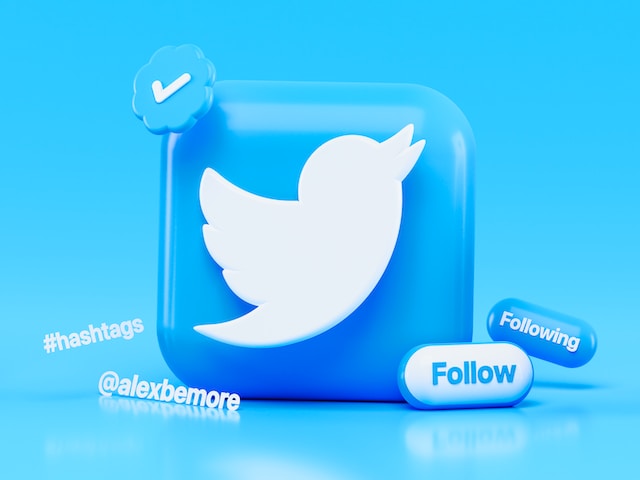Choosing the right social media platforms for your business involves a mix of research, strategy, and adaptability. By aligning with your audience, setting clear goals, and staying attuned to platform dynamics, your business can navigate the social media landscape with confidence.
Remember, it's not about being on every platform: it's about being on the right ones for your business's success.
Let's explore 8 actionable tips to guide you in choosing the right social media platform for your business.

- Tip 1: Know Your Audience
- Tip 2: Clarify Your Business Goals
- Tip 3: Analyze Platform Features
- Tip 4: Examine Your Content Type
- Tip 5: Research Competitor Presence
- Tip 6: Explore Advertising Options
- Tip 7: Track Platform Analytics
- Tip 8: Stay Flexible and Experiment
- 6 Popular Social Networks: Navigating Demographics and Preferences
- Wrapping up
Tip 1: Know Your Audience
Understanding your audience is not merely the first step.
It's the foundation upon which a successful social media strategy is built.
In essence, comprehending your audience extends beyond surface-level demographics.
It requires a nuanced understanding of their behaviors, preferences, and the evolving dynamics shaping their online experience.
Armed with this knowledge, your journey towards choosing the right social media platform becomes not just strategic but deeply attuned to the heartbeat of your audience.
Here's a deeper dive into unraveling the intricacies of your audience:
Demographic Insights
Delve into the demographics of your target audience. Age, gender, location, and income levels play pivotal roles in determining the platforms where your audience is most active.
Tools like Google Analytics and social media insights can provide valuable demographic data.
Psychographic Understanding
Beyond demographics, grasp the psychographics of your audience. Uncover their interests, preferences, and behaviors.
This insight allows you to tailor your content to resonate on a more personal level, fostering a stronger connection.
Social Listening
Engage in social listening to understand the conversations surrounding your industry or niche.
Monitoring discussions on various platforms provides a real-time pulse of your audience's sentiments, concerns, and interests.
User Persona Creation
Create detailed user personas representing your ideal audience segments.
These fictional characters embody the characteristics of your target audience and serve as guides for crafting content that speaks directly to their needs and aspirations.
Competitor Analysis
While discussed in later points, early-stage competitor analysis also contributes to understanding your audience.
Analyzing your competitors' followers can reveal shared interests and preferences, offering valuable clues for your strategy.
Feedback Channels
Leverage feedback channels, such as comments, messages, and surveys, to directly interact with your audience.
Actively seek their opinions on content, preferences, and expectations, fostering a collaborative relationship.
Platform-Specific Insights
Different platforms offer unique insights into audience behavior.
Instagram, for instance, provides detailed data on when your followers are most active.
Utilize these platform-specific analytics to refine your posting schedule and maximize engagement.
Adaptability to Trends
Understand the evolving trends within your audience demographic.
Stay attuned to cultural shifts, emerging preferences, and viral content that captivates your audience.
Adaptability ensures your content remains relevant and resonant.
Tip 2: Clarify Your Business Goals
Defining your business goals provides the compass for navigating the vast sea of social media platforms.
By crystallizing your business goals, you embark on a purpose-driven social media journey.
Each platform becomes a tool strategically selected to achieve specific objectives, ensuring that your efforts align with the broader vision and mission of your business.
As we delve deeper into platform features and content strategies, this clarity will serve as your North Star in navigating the dynamic landscape of social media.
Let's explore key considerations to align your business objectives with the strengths of different social media channels:
Brand Awareness
If your primary goal is to enhance brand visibility and recognition, platforms emphasizing visual content, such as Instagram and Pinterest, are powerful allies.
These platforms thrive on aesthetically pleasing content that can leave a lasting imprint on your audience's memory.
Lead Generation
For businesses focused on lead generation, platforms offering targeted advertising and robust analytics, like Facebook become strategic choices.
These platforms provide sophisticated ad targeting options to reach audiences with specific demographics and interests.
Community Building
If fostering a sense of community around your brand is a priority, platforms with strong community features, such as Facebook Groups, can be instrumental.
These spaces allow for direct interaction with your audience, building a loyal and engaged community.
E-commerce and Sales
For businesses heavily reliant on e-commerce, platforms with integrated shopping features, like Instagram and Facebook, offer seamless options for showcasing products and driving sales directly from the platform.
Explore e-commerce-friendly functionalities to streamline the purchasing journey.
Engagement and Interaction
If fostering high levels of engagement and interaction is a central goal, platforms like Twitter and TikTok, known for their real-time and interactive nature, can be leveraged.
These platforms thrive on quick, engaging content that encourages immediate audience participation.
Educational Content
For businesses aiming to provide educational content, platforms supporting longer video formats, such as YouTube, become indispensable.
The extended format allows for in-depth tutorials, explanations, and valuable educational content.
Reputation Management
For reputation management and crisis communication, platforms with high user engagement and sharing capabilities, like Twitter, enable swift responses and transparent communication. Monitoring and addressing concerns promptly contribute to brand trust.
Global Expansion
For businesses eyeing global expansion, platforms with a broad international user base, such as Instagram and Facebook, provide the reach needed to connect with diverse audiences across the globe.
Leverage language targeting and cultural sensitivity to resonate with varied demographics.
Tip 3: Analyze Platform Features
Every social media platform is equipped with a unique set of features, akin to tools in a digital toolbox.
Analyzing these features is essential to harnessing the full potential of each platform.
By comprehensively analyzing platform features, you gain a strategic understanding of the tools each platform provides.
Tailor your social media strategy by leveraging the unique strengths of each platform, ensuring that your content is not only engaging but maximally effective in achieving your business goals.
As we progress, we'll further explore content creation strategies aligned with these features, enhancing your ability to captivate and grow your audience.
Let's explore key considerations when evaluating platform features:
Content Format and Flexibility
Different platforms excel in specific content formats. Instagram is renowned for visual content, TikTok for short-form videos, and YouTube for a variety of content types, from tutorials to vlogs.
Understand the content format that aligns with your brand and resonates with your audience.
Advertising Opportunities
Evaluate the advertising options available on each platform.
Facebook and Instagram offer highly targeted ads, while platforms like Pinterest excel in visual advertising.
YouTube, with its extensive reach, provides opportunities for both traditional ads and influencer collaborations, offering diverse advertising avenues.
Audience Targeting Capabilities
Understanding a platform's audience targeting capabilities is crucial for reaching your ideal demographic.
Platforms like Twitter allow for precise targeting based on interests and keywords.
YouTube's algorithm, driven by user behavior, helps tailor content recommendations to a wide range of audience interests.
Analytics and Insights
Access to robust analytics is indispensable for refining your social media strategy.
Platforms like Facebook and Instagram provide detailed insights into post performance, audience demographics, and engagement metrics.
YouTube offers analytics on video performance, audience demographics, and viewer engagement, enabling data-driven decisions.
Community and Group Features
For brands prioritizing community building, platforms with strong community and group features are advantageous.
Facebook Groups are well-known for fostering engaged communities.
YouTube, with its comment sections and community tab, allows for direct interaction and community engagement.
Shopping and E-commerce Integration
If e-commerce is a significant aspect of your business, platforms with integrated shopping features streamline the path from discovery to purchase.
Instagram and Facebook offer such functionalities, while YouTube, through annotations and links in video descriptions, can direct viewers to product pages and online stores.
Storytelling Opportunities
Storytelling is a powerful tool in social media marketing.
Platforms like Snapchat and Instagram provide features like Stories that allow for creative and temporary content sharing.
On YouTube, vlogs, and day-in-the-life videos create an opportunity for authentic and immersive storytelling.
Live Video Capabilities
Live video has become a prominent feature on various platforms.
Facebook, Instagram, and YouTube offer live streaming capabilities, providing opportunities for real-time engagement and connection with your audience.
Global Reach and Language Support
For brands targeting a global audience, platforms with broad international reach and multilingual support are advantageous.
Twitter and Instagram facilitate global connections, and YouTube, being a video-centric platform, breaks language barriers through visual communication.
Tip 4: Examine Your Content Type
The nature of your content is the heartbeat of your social media strategy.
Each platform resonates differently with various content types.
By carefully examining your content type, you can tailor your strategy to the strengths of each platform.
Let's explore considerations for examining and tailoring your content type to optimize your social media presence:
Visual Content Platforms
Certain platforms thrive on visually appealing content.
Instagram, Pinterest, and TikTok are visual-centric platforms where images and short videos take center stage.
Craft visually stunning content that aligns with your brand aesthetic to captivate the audience scrolling through their feeds.
Video-Centric Platforms
Video content reigns supreme on platforms like YouTube and TikTok.
Consider creating engaging and informative videos that cater to your audience's preferences.
YouTube, in particular, allows for various video formats, including tutorials, vlogs, and storytelling, offering versatility in content creation.
Interactive Content Platforms
Interactive content fosters engagement. Platforms like Twitter, Instagram Stories, and Facebook offer features like polls, quizzes, and interactive stickers.
Experiment with these features to encourage audience participation and gather valuable insights.
Ephemeral Content Platforms
Ephemeral content, which disappears after a short period, is popular on platforms like Snapchat and Instagram Stories.
Leverage this temporary nature to share behind-the-scenes glimpses, limited-time promotions, or exclusive content, creating a sense of urgency.
User-Generated Content Platforms
Encouraging users to create content for your brand is a powerful strategy.
Platforms like Instagram, TikTok, and YouTube allow users to generate content related to your products or services.
Embrace and showcase user-generated content to build a sense of community.
Podcasting Platforms
If your content strategy includes podcasts, platforms like Spotify or Apple Podcasts offer opportunities to share audio content.
Use social media to promote and share snippets, enticing your audience to tune in for the full episodes.
Adaptability to Trends
Stay attuned to content trends within your niche. Platforms like Twitter, known for real-time updates, provide an excellent avenue for participating in trending conversations.
Adapt your content strategy to incorporate trending topics, keeping your brand relevant and timely.
Cross-Platform Integration
Consider how your content can seamlessly integrate across multiple platforms.
Repurpose content to suit the unique characteristics of each platform while maintaining a consistent brand voice and message.
Tip 5: Research Competitor Presence
Analyzing your competitors' social media presence is akin to peering into the playbook of industry players.
By meticulously researching your competitors' social media presence, you gain a strategic advantage.
The insights gleaned provide a roadmap for refining your own strategy, identifying areas for improvement, and capitalizing on opportunities that competitors may have overlooked.
As we delve deeper into optimizing your social media strategy, these insights will serve as valuable benchmarks for achieving and surpassing industry standards.
Here's how you can leverage competitor research to refine your own social media strategy:
Identify Competitors
Begin by identifying your direct competitors—those operating in your industry or niche.
Look for businesses with a similar target audience, products, or services.
These are the players whose social media strategies can offer valuable insights.
Examine Platform Presence
Explore which social media platforms your competitors are active on.
Take note of their frequency of posting, the type of content they share, and the level of engagement they receive.
Platforms where competitors thrive may be worthwhile for your brand as well.
Content Analysis
Dive into the nature of your competitors' content.
Identify the content types that garner the most engagement. Whether it's visually appealing images, informative videos, or engaging polls, understanding what resonates with their audience provides insights for your content strategy.
Follower Demographics
Explore the demographics of your competitors' followers.
Platforms like Instagram provide insights into follower demographics, including age, gender, and location.
This information can guide your targeting strategy and help you tailor content to a similar audience.
Engagement Levels
Measure the engagement levels on your competitors' posts.
Analyze the number of likes, comments, and shares to gauge the effectiveness of their content.
Identify patterns in high-engagement posts and consider how you can incorporate similar elements into your strategy.
Discover Content Gaps
Identify content gaps in your competitors' strategies.
Are there topics or types of content that your competitors are not covering?
This presents an opportunity for your brand to fill those gaps and provide unique value to the audience.
Monitor Campaigns and Promotions
Keep an eye on any campaigns, promotions, or collaborations your competitors are running.
Analyze the strategies behind their promotional activities and assess the audience response.
This information can guide your approach to running successful campaigns.
Evaluate Response to Customer Feedback
Examine how your competitors respond to customer feedback, reviews, and queries on social media.
Assess the tone, responsiveness, and effectiveness of their customer interactions.
Learn from their successes and shortcomings to refine your customer engagement strategy.
Assess Social Media Advertising
Explore your competitors' social media advertising efforts.
Identify the platforms where they invest in paid promotions and the types of ads they run.
Analyzing their advertising strategies can inform your decisions on budget allocation and ad content.
Track Follower Growth
Monitor the growth of your competitors' social media followings.
A rapidly growing follower count may indicate successful strategies.
Analyze the tactics contributing to their growth and consider incorporating similar approaches into your own growth strategy.
Tip 6: Explore Advertising Options
Effectively leveraging social media advertising can significantly boost your brand's visibility.
Exploring advertising options on social media requires a strategic approach.
By understanding the unique features of each platform, tailoring your ads to specific audiences, and continuously analyzing performance, you can unlock the full potential of social media advertising to amplify your brand's reach and impact.
Here's how you can explore and optimize advertising options on various platforms:
Platform-Specific Ads
Different social media platforms offer unique advertising formats.
Familiarize yourself with these formats and choose those that align with your campaign goals.
For instance, Instagram's visually-driven sponsored posts might be ideal for showcasing products.
Targeted Advertising
Harness the power of targeted advertising to reach specific demographics.
Platforms like Facebook and Instagram allow you to define your audience based on factors such as age, location, interests, and behaviors.
Refining your targeting ensures your ads are seen by the most relevant audience.
Ad Creatives and Copywriting
Invest time in crafting compelling ad creatives and copy.
Capture attention with visually appealing graphics or videos and pair them with concise, persuasive copy.
A/B testing different creatives can help identify what resonates best with your audience, refining your approach over time.
Budget Optimization
Set a realistic budget for your social media advertising campaigns.
Understand the bidding and budgeting options available on each platform.
Platforms like Facebook and Instagram allow you to choose between daily and lifetime budgets, giving you flexibility in managing campaign costs.
Ad Scheduling
Optimize your ad scheduling to ensure your content reaches your audience at the most impactful times.
Analyze when your target audience is most active on each platform and schedule your ads accordingly. This can enhance visibility and engagement.
Promoted Posts
Consider using promoted posts to amplify the reach of your organic content.
Platforms like Twitter and Facebook offer the option to boost the visibility of your regular posts to a wider audience.
This can be an effective way to increase engagement and attract new followers.
Influencer Collaborations
Explore partnerships with influencers who align with your brand.
Influencers can help amplify your message to their followers, providing a trusted voice for your products or services.
Ensure that influencers' values align with your brand for authentic collaborations.
Carousel Ads and Slideshows
Take advantage of interactive ad formats like carousel ads and slideshows.
Platforms like Facebook and Instagram allow you to showcase multiple images or videos in a single ad, providing a dynamic and engaging way to tell your brand story.
Video Advertising
Video content continues to dominate social media. Platforms like YouTube, Instagram, and TikTok provide opportunities for video advertising.
Create compelling and concise videos that capture attention and convey your brand message effectively.
Remarketing Strategies
Implement remarketing strategies to reconnect with users who have interacted with your brand but haven't converted.
Platforms like Google Ads and Facebook allow you to create targeted ads specifically for this audience, increasing the chances of conversion.
Performance Analysis
Regularly analyze the performance of your advertising campaigns.
Review metrics such as click-through rates, conversion rates, and return on ad spend.
Use these insights to refine your targeting, creative elements, and overall strategy for continuous improvement.
Budget Flexibility
Maintain flexibility in your advertising budget based on campaign performance.
Platforms often provide tools for adjusting budgets mid-campaign. Allocate more budget to well-performing ads and reallocate resources from underperforming ones to optimize your overall spend.
Tip 7: Track Platform Analytics
Analyzing platform analytics is crucial for understanding the performance of your social media strategy and making informed decisions.
Effectively tracking platform analytics is a cornerstone of strategic growth on social media.
By gaining insights into audience behavior, content performance, and overall strategy effectiveness, you can refine your approach for optimal results.
Here's how you can effectively track and utilize platform analytics:
Understanding Key Metrics
Familiarize yourself with key metrics on each social media platform.
Metrics may include reach, engagement, clicks, impressions, and conversion rates.
Each metric provides a unique perspective on the effectiveness of your content and overall strategy.
Platform-Specific Analytics Tools
Explore the analytics tools provided by each platform.
Platforms like Facebook, Instagram, and Twitter offer insights dashboards where you can access detailed analytics.
Utilize these tools to monitor performance, audience demographics, and content engagement.
Define KPIs (Key Performance Indicators)
Establish clear KPIs aligned with your business objectives.
Whether your goal is brand awareness, lead generation, or sales, defining specific KPIs allows you to measure success and adjust your strategy accordingly.
Common KPIs include: conversion rates, click-through rates, and follower growth.
Regular Performance Reviews
Conduct regular reviews of your analytics data.
Set aside dedicated time to analyze performance trends, identify patterns, and uncover areas for improvement.
Regular reviews ensure that you stay informed about the evolving dynamics of your audience and industry.
Audience Demographics
Delve into audience demographics provided by platform analytics.
Understand the age, gender, location, and interests of your audience.
This information helps tailor content to resonate with your target demographic and informs strategic decisions on ad targeting.
Content Performance Analysis
Evaluate the performance of individual pieces of content.
Identify high-performing content based on engagement metrics.
Determine the types of posts, visuals, and topics that resonate most with your audience, and replicate successful elements in future content.
Optimal Posting Times
Analyze data to identify optimal posting times.
Platforms often provide insights into when your audience is most active. Schedule your posts during these peak times to maximize visibility and engagement.
Experiment with different posting schedules and monitor their impact.
Conversion Tracking
Implement conversion tracking to measure the effectiveness of your social media campaigns in driving desired actions.
Whether it's website visits, form submissions, or purchases, tracking conversions provides valuable insights into the impact of your social media efforts on business outcomes.
Competitor Benchmarking
Compare your analytics data with that of competitors.
Benchmarking allows you to assess your performance relative to industry standards. Identify areas where you outperform competitors and areas for improvement.
This competitive analysis informs strategic adjustments.
Attribution Models
Explore attribution models to understand the customer journey.
Different touchpoints contribute to a customer's decision-making process.
Attribution models help you identify which channels and interactions play a significant role in converting prospects into customers.
A/B Testing
Implement A/B testing to optimize various elements of your strategy.
Test different ad creatives, posting times, and content types to identify what resonates best with your audience.
A/B testing provides data-driven insights for refining your approach over time.
Utilize Third-Party Analytics Tools
Consider using third-party analytics tools for a comprehensive view of your social media performance.
Tools like Google Analytics, Hootsuite Analytics, and Sprout Social offer additional features and integrations for in-depth analysis and reporting.
Adapt Strategies Based on Insights
Adapt your social media strategies based on insights gained from analytics.
If certain types of content perform exceptionally well, incorporate more of that content into your strategy.
Likewise, adjust targeting, posting frequency, and ad spend based on performance data.
Long-Term Trend Analysis
Conduct long-term trend analysis to identify overarching patterns and seasonality.
Understanding long-term trends helps you anticipate changes in audience behavior, allowing you to proactively adjust your strategy to align with evolving preferences.
Tip 8: Stay Flexible and Experiment
In the ever-evolving realm of social media, flexibility and experimentation are key to staying ahead.
In the ever-shifting landscape of social media, staying flexible and experimenting are indispensable.
By embracing change, adapting strategies based on insights, and fostering a culture of experimentation, you position your brand to not only thrive in the present but also to anticipate and shape the future of your social media presence.
Here's how you can navigate the dynamic landscape, adapt to changes, and discover new opportunities:
Embrace Platform Changes
Social media platforms regularly introduce updates and changes.
Stay informed about these changes and embrace them as opportunities.
Features like algorithm updates, new ad formats, and interface changes can offer fresh avenues for engagement and visibility.
Test New Content Formats
Experiment with diverse content formats to keep your strategy dynamic.
From live videos and stories to interactive polls and quizzes, testing new formats allows you to gauge audience preferences.
Identify which formats resonate best and integrate them into your regular content calendar.
Explore Emerging Platforms
Keep an eye on emerging social media platforms.
While established platforms have their merits, exploring new and emerging ones can offer early-mover advantages.
Test the waters on platforms gaining traction within your target demographic and industry.
Iterate Based on Feedback
Act on feedback from your audience.
Social media provides a direct line of communication with your followers.
Leverage comments, direct messages, and surveys to gather feedback.
Use this valuable input to iterate on your content, address concerns, and refine your approach.
Monitor Industry Trends
Stay abreast of industry trends beyond social media platforms.
Changes in consumer behavior, technological advancements, and cultural shifts can impact social media dynamics.
Being attuned to broader trends allows you to align your strategy with the evolving landscape.
Collaborate and Network
Collaborate with others in your industry or related fields.
Networking on social media can lead to partnerships, cross-promotions, and exposure to new audiences.
Engaging with influencers and thought leaders can bring fresh perspectives and opportunities for collaboration.
Adopt a Test-and-Learn Approach
Embrace a test-and-learn mentality.
Implement small-scale experiments to assess the viability of new strategies or tactics.
Whether it's testing different ad creatives, posting times, or content themes, a test-and-learn approach helps identify what works best for your unique audience.
Attend Virtual Events and Webinars
Participate in virtual events and webinars related to social media and digital marketing.
These events often provide insights from industry experts, showcase successful case studies, and offer a forum for networking.
Apply the knowledge gained to enhance your social media strategy.
Cross-Promotion Opportunities
Explore cross-promotion opportunities with other businesses or influencers.
Cross-promotions can expand your reach by tapping into each other's audiences.
Identify synergies with partners whose values align with yours for mutually beneficial collaborations.
Stay Agile in Response to Data
Be agile in responding to data and analytics.
If specific content performs exceptionally well or if audience demographics shift, be ready to adjust your strategy accordingly.
Regularly revisit your social media plan based on the insights gleaned from ongoing analytics.
Encourage User-Generated Content (UGC)
Encourage your audience to generate content.
User-generated content not only diversifies your content but also fosters community engagement.
Contests, challenges, and hashtags can inspire your audience to create content related to your brand.
Monitor Conversations and Trends
Stay vigilant about ongoing conversations and trends.
Monitoring social media for trending topics, hashtags, and discussions allows you to join relevant conversations.
Being a part of trending topics can enhance visibility and connect your brand with current cultural narratives.
Audit and Refine Regularly
Conduct regular audits of your social media strategy.
Assess what's working, what needs refinement, and what could be discarded.
Regularly refining your strategy ensures that it aligns with your evolving business goals and the dynamic social media landscape.
Balancing Consistency with Adaptability
While experimentation is crucial, balance it with consistency.
Maintain a consistent brand voice, visual identity, and posting schedule.
Consistency builds trust with your audience, while adaptability allows you to embrace new opportunities and respond to changes effectively.
Celebrate Successes and Learn from Failures
Celebrate your successes, no matter how small.
Recognize and replicate the elements that contribute to success.
Similarly, learn from failures and setbacks.
Analyze what didn't work, extract valuable lessons, and apply those insights to improve future strategies.
6 Popular Social Networks: Navigating Demographics and Preferences
As you embark on the journey to choose the ideal social media platforms for your business, understanding the demographics and dynamics of popular networks is instrumental.
By strategically selecting the platforms that align with your brand and industry, you set the stage for effective engagement and growth.
Let's explore some of the leading social networks, shedding light on their user demographics, age ranges, and other relevant information to help you make informed decisions.
1. Instagram: Visual Storytelling Mastery
Instagram is a visual haven where businesses showcase their creativity.

From stunning images to engaging Stories, it's a platform where visual storytelling takes center stage, making it perfect for lifestyle brands and influencers.
Demographics:
- Age Range: Predominantly popular among users aged 18 to 34, making it ideal for brands targeting a younger demographic.
- Visual Focus: Recognized for its visual content, Instagram is particularly suitable for businesses with visually appealing products or services.
Platform Dynamics:
- Content Types: Primarily focuses on visual content, including images, videos, and Instagram Stories.
- Engagement Features: High engagement rates, particularly with visually striking and authentic content.
2. YouTube: The Video Content Hub
YouTube is the ultimate video content hub, offering a platform for content creators and businesses to share tutorials, reviews, and engaging video content.

It's a go-to destination for those seeking in-depth information and entertainment.
Demographics:
- Age Range: Diverse user base, with a significant presence across age groups. Popular among users aged 18 to 49.
- Content Consumption: Known for video content, making it suitable for businesses emphasizing tutorials, vlogs, and product showcases.
Platform Dynamics:
- Content Types: Video content ranging from short clips to long-form content.
- Engagement Features: Comments, likes, and subscriptions drive user engagement.
3. Facebook: The All-Inclusive Giant
Facebook is the pioneer of social media, offering a diverse platform for individuals and businesses.

It caters to a broad spectrum of interests, providing a space for community building, content sharing, and brand promotion.
Demographics:
- Age Range: While once known as a platform for younger audiences, Facebook has diversified its user base. It now spans all age groups, with a significant presence of users aged 25 to 54.
- Global Reach: With over 2.8 billion monthly active users, Facebook remains a global giant, making it an essential consideration for businesses with broad audience appeal.
Platform Dynamics:
- Content Types: Supports a variety of content types, including text, images, videos, and live streaming.
- Engagement Features: Offers features like Groups and Pages for community building and brand promotion.
4. TikTok: The Short-Form Creativity Haven
TikTok is the epitome of short-form creativity.

It's a platform where trends go viral, and users express themselves through innovative and entertaining short videos, making it a hotbed for viral marketing.
Demographics:
- Age Range: Primarily appeals to a younger audience, with a significant user base in the 16 to 24 age range.
- Creative Expression: Known for short-form videos, making it ideal for brands that can convey messages through creativity.
Platform Dynamics:
- Content Types: Short, engaging videos set to music, emphasizing creativity and trends.
- Engagement Features: Viral challenges and trends drive user engagement.
5. Pinterest: Visual Discovery and Inspiration
Pinterest is the visual discovery engine where users curate ideas and inspiration through visually appealing pins.
Businesses with a focus on lifestyle, fashion, and design find a home on this platform.
Demographics:
- Age Range: Attracts a predominantly female audience, with a significant user base in the 18 to 49 age range.
- Visual Discovery: Perfect for businesses with visually appealing products or those focused on lifestyle and inspiration.
Platform Dynamics:
- Content Types: Users create and share visual bookmarks or 'pins' linked to websites.
- Engagement Features: Discovery through visually curated boards and pins.
6. Twitter (X): Real-Time Conversations
Twitter is the go-to platform for real-time conversations and breaking news.

Its character-limited format encourages concise and impactful messaging, making it a dynamic space for engagement.
Demographics:
- Age Range: Attracts a diverse audience, with a higher concentration of users aged 18 to 49.
- News and Trends: Known for real-time updates, Twitter is a hub for news, trends, and timely conversations.
Platform Dynamics:
- Content Types: Limited character count per tweet encourages concise and engaging content.
- Engagement Features: Retweets, likes, and replies facilitate quick interaction and sharing of content.
Wrapping up
Embark on this journey armed with insights, experiment boldly, and witness how the right social media choices can propel your business to new heights of visibility, engagement, and lasting success.
Here's to your brand's social media journey—a journey filled with strategic choices and endless possibilities.
